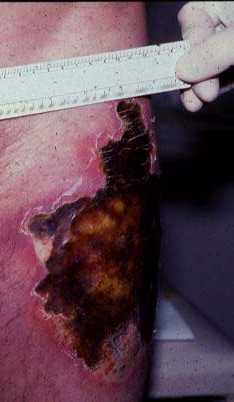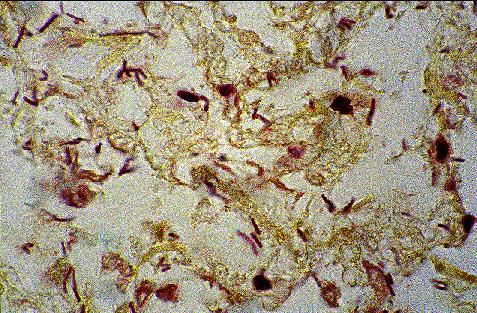Clostridium Terfringens and Gas Gangrene
by Justin Barnes

 Gangrene is the condition of a limb being cut off from
its blood supply. It occurs when there are extreme environmental factors
such as freezing cold (dry gangrene) or through bacterial infection of
open wound (moist gangrene). Moist gangrene occurs when the blood supply
is cut off long enough that cells in the isolated limb begin to die and
secrete pus and other fluids. This moist environment is the perfect place
for bacteria to grow. If some clostridium-strain bacteria (and sometimes
other strains) infect this area then there can be real complications for
the host such as gas gangrene (the condition in which highly reproductive
bacteria infect the area and spread quickly producing small gas bubbles
beneath the skin of the host).
Gangrene is the condition of a limb being cut off from
its blood supply. It occurs when there are extreme environmental factors
such as freezing cold (dry gangrene) or through bacterial infection of
open wound (moist gangrene). Moist gangrene occurs when the blood supply
is cut off long enough that cells in the isolated limb begin to die and
secrete pus and other fluids. This moist environment is the perfect place
for bacteria to grow. If some clostridium-strain bacteria (and sometimes
other strains) infect this area then there can be real complications for
the host such as gas gangrene (the condition in which highly reproductive
bacteria infect the area and spread quickly producing small gas bubbles
beneath the skin of the host).
 Gas gangrene is the most deadly type of gangrenous infection
because it spreads so rapidly and does the most damage. The bubbles of
gas given off are the waste product of the tissues beneath being eaten
by the bacteria. Severe gangrene infections can spread at rates up to an
inch an hour.
Gas gangrene is the most deadly type of gangrenous infection
because it spreads so rapidly and does the most damage. The bubbles of
gas given off are the waste product of the tissues beneath being eaten
by the bacteria. Severe gangrene infections can spread at rates up to an
inch an hour.
Common symptoms of gangrenous infections are weeping
wounds, brown pus, foul or sweet smell and visible rotting of the flesh.
Treatments are mostly limited to penicillin although other antibacterial
works. If the infection is beneath the surface of the skin, the dead tissues
must be removed and penicillin must be given both intravenously and topically.
In the US alone 900-1000 reported cases are recorded
each year for humans. 25% of the gas gangrene infected victims die. The
bacteria can infect any species that can sustain injuries cutting off the
blood supply to the limbs.
Bibliography
http://www.bu.edu/cohis/infxns/bacteria/prfngens.htm
http://brooks.pvt.k12.ma.us/~bheun/gg.html
http://www.emedicine.com/EMERG/topic211.htm
Return
to Bacterial Disease Page




